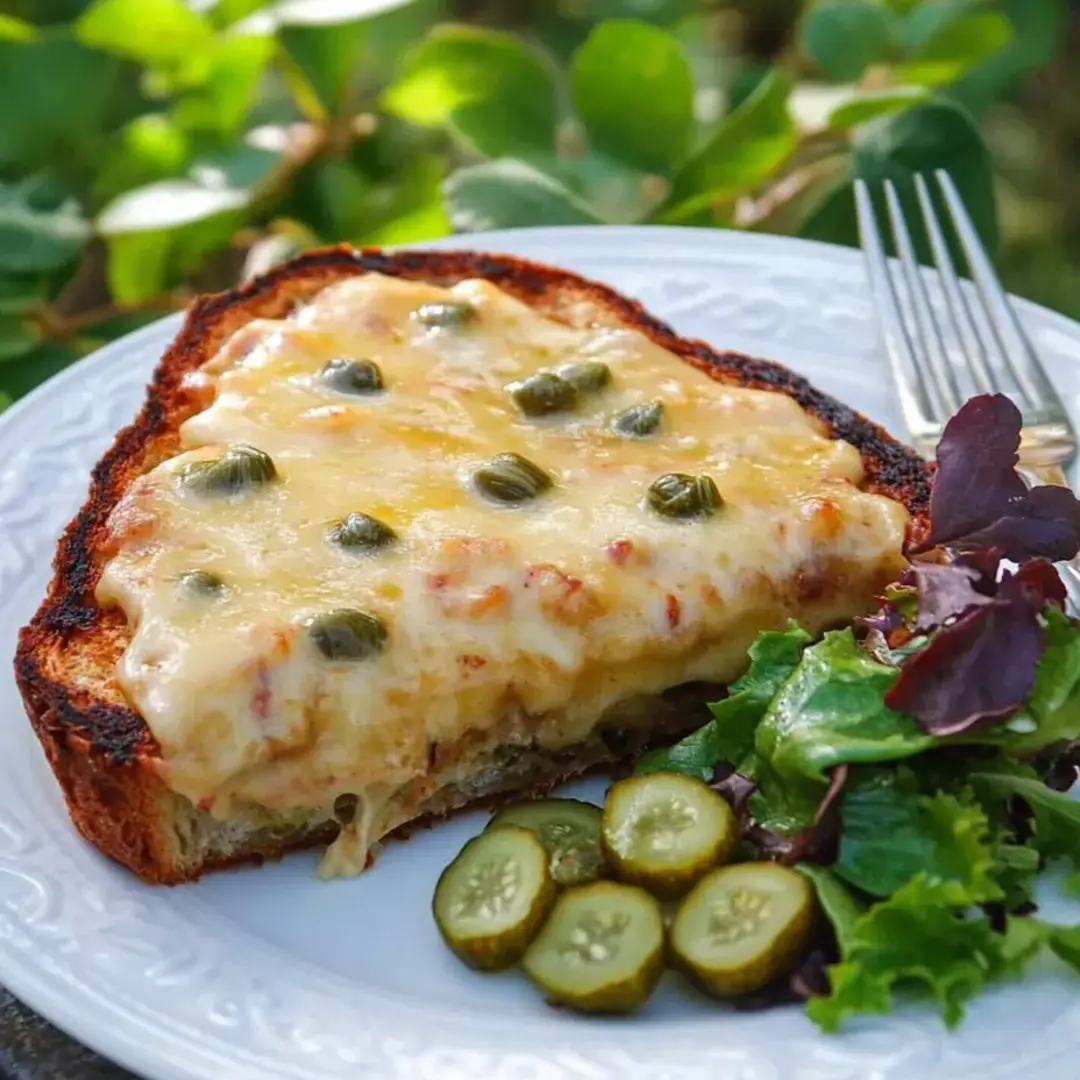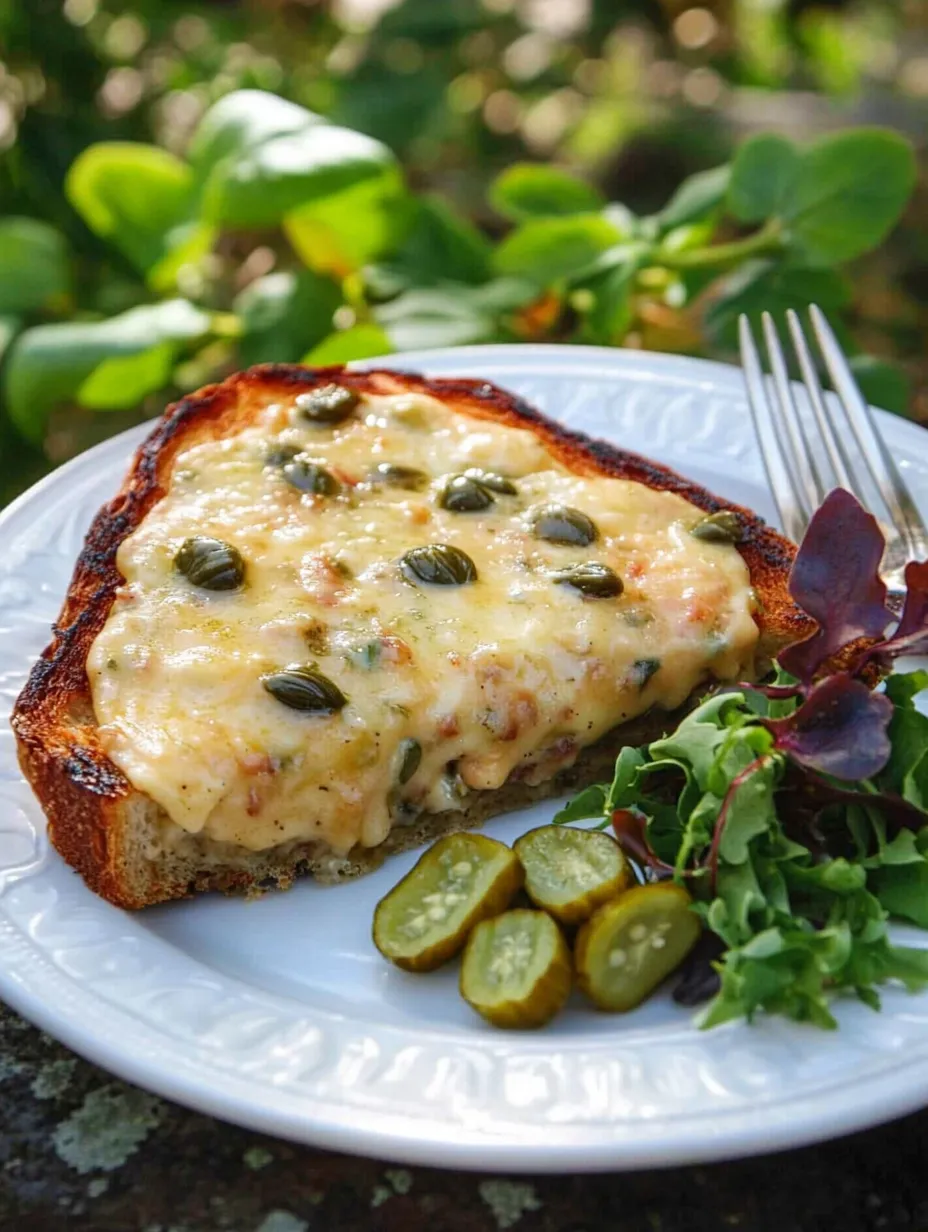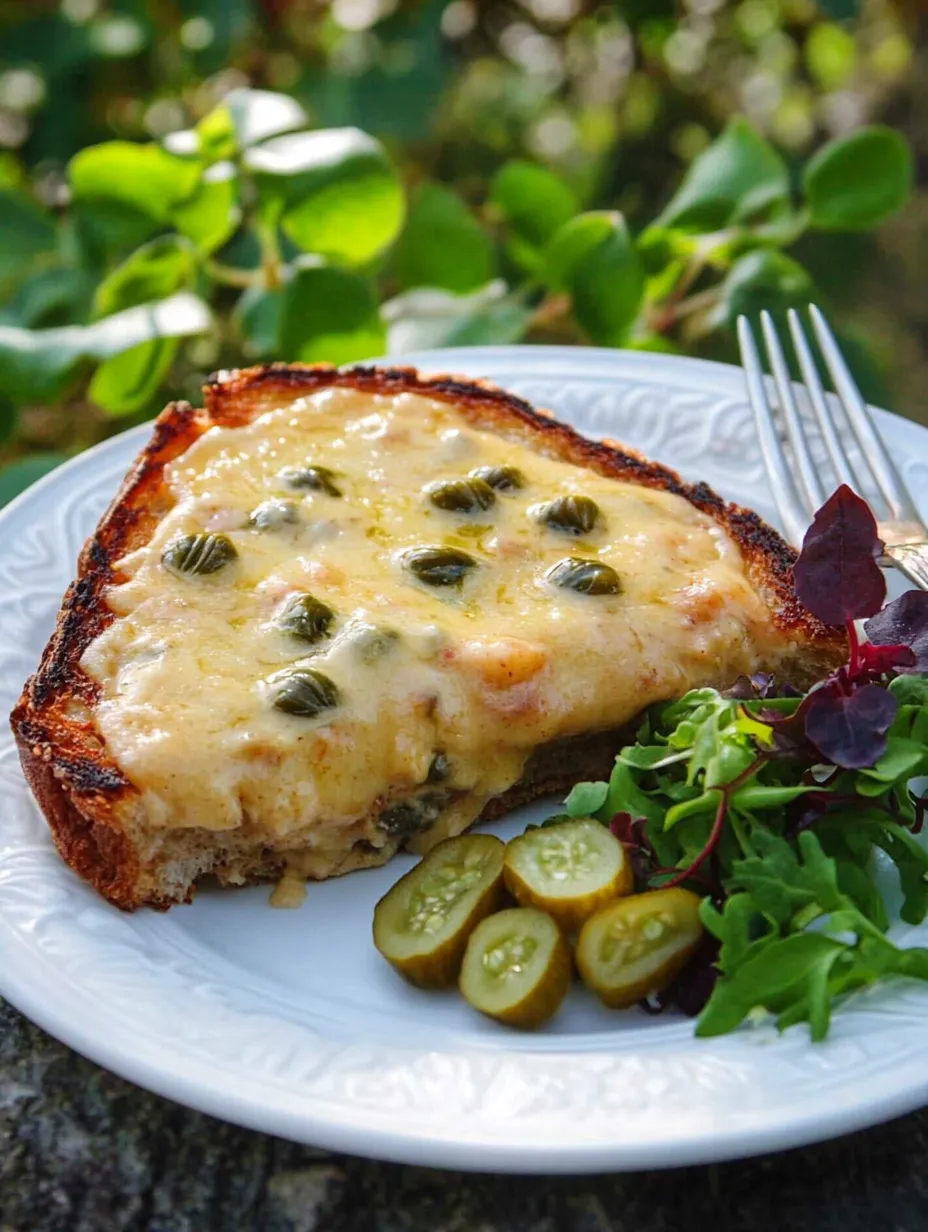 Pin it
Pin it
Irish Rarebit transforms humble ingredients into a luxurious open-faced sandwich that delivers pure comfort in every bite. This cousin to the classic Welsh version features quality Irish cheddar melted into a velvety sauce that's tangy, rich, and slightly sharp, all cascading over thick-cut toast with a perfectly crispy exterior and pillowy interior. The addition of chopped gherkins adds unexpected bursts of brightness that cut through the richness, creating a perfect balance of flavors. Whether served as a satisfying lunch, quick dinner, or indulgent late-night snack, this elevated cheese toast delivers complex flavors and textures while remaining beautifully simple to prepare – true comfort food that nourishes both body and soul.
I discovered Irish rarebit during a rainy afternoon in Dublin when I ducked into a small pub seeking shelter. What arrived at my table looked deceptively simple – just toast with cheese – but that first bite revealed incredible depth of flavor and comfort. When I recreated it at home for friends, my neighbor (who typically prefers "fancy" food) practically licked her plate clean and immediately asked for the recipe. Her college-age son now makes it regularly in his dorm room using just a toaster oven and hotplate! This dish proves that true culinary magic often comes from transforming the simplest ingredients.
Ingredients
- 2 tablespoons butter: Creates the rich base for your sauce. European-style butter with its higher fat content provides exceptional flavor, but any good quality butter works beautifully.
- 1/4 cup milk: Helps create the perfect sauce consistency. Whole milk yields the creamiest texture, though 2% works in a pinch.
- 8 ounces Irish cheddar cheese, grated: The star ingredient deserves the spotlight. Kerrygold Dubliner offers authentic flavor with the perfect balance of sharpness and meltability.
- 1 teaspoon white vinegar: Adds brightness and tang that balances the richness of the cheese. For an unconventional but delicious twist, substitute Guinness (though purists might raise an eyebrow).
- 1 teaspoon prepared English mustard: Provides subtle heat and depth. Colman's is traditional, but Dijon can substitute if necessary.
- 1/4 teaspoon freshly ground black pepper: Adds gentle warmth and complexity. Freshly ground pepper offers significantly more flavor than pre-ground.
- 2 tablespoons chopped gherkins or cornichons: Creates unexpected pops of acidity and crunch that cut through the richness. The small size of cornichons makes them ideal for even distribution throughout the sauce.
- 4 thick slices of crusty bread: Provides the sturdy foundation for your cheese topping. Artisanal sourdough or a homemade no-knead bread offers the best texture contrast.
I'm particularly passionate about the cheese selection for this recipe. After experimenting with various options, I've found that authentic Irish cheddar, with its distinct flavor profile developed through traditional aging techniques, creates a depth of flavor that other cheeses simply can't match. The slightly sweet, nutty notes of Kerrygold Dubliner complement the tangy gherkins perfectly, creating a beautifully balanced bite.
 Pin it
Pin it
Step-by-Step Instructions
- Step 1: Prep Broiler
- Begin by positioning an oven rack about 6 inches from your broiler element and preheating the broiler to high. This proximity allows for quick browning of the cheese without overcooking the bread beneath. Line a baking sheet with foil for easy cleanup later.
- Step 2: Toast Bread
- Arrange your bread slices on the prepared baking sheet. Toast them under the broiler for 1-2 minutes until just the top sides are golden brown. Watch them carefully as they can go from perfectly toasted to burnt in seconds. Once toasted, remove from the oven but leave the broiler on. You're only toasting one side because the untoasted side will absorb some of the sauce while the toasted side remains crisp.
- Step 3: Make Cheese Sauce
- While the bread toasts, prepare the cheese sauce. Start by melting the butter in a medium saucepan over low heat. Low heat is crucial here—too high, and the sauce can separate or become grainy. The butter should melt gently, forming a smooth, foamy layer.
- Step 4: Add Milk
- Once the butter has completely melted, pour in the milk and stir to combine. Allow the mixture to warm for about 30 seconds—this prevents the shock of cold milk hitting hot butter, which can cause separation.
- Step 5: Melt Cheese
- Add the grated cheese to the warm milk mixture a handful at a time, stirring constantly with a wooden spoon. This gradual addition prevents clumping and ensures a silky-smooth sauce. Continue stirring until all cheese is melted and the sauce has a uniform, velvety consistency with no visible cheese strands.
- Step 6: Add Vinegar
- Pour in the vinegar (or Guinness) and stir to incorporate. The acid adds brightness while helping to stabilize the emulsion. You'll notice the sauce becomes slightly looser at this point.
- Step 7: Season
- Add the prepared mustard and freshly ground black pepper, stirring to distribute evenly throughout the sauce. The mustard provides a subtle heat that complements the sharpness of the cheddar without overwhelming it.
- Step 8: Add Gherkins
- Gently fold in the chopped gherkins or cornichons, distributing them evenly throughout the sauce. These tiny pickles add bright bursts of flavor and delightful textural contrast to each bite. Their acidity also helps cut through the richness of the cheese.
- Step 9: Cool Slightly
- Remove the sauce from heat and allow it to cool slightly for 1-2 minutes, stirring occasionally. This brief cooling period allows the sauce to thicken slightly, which helps it cling better to the bread without running off the edges.
- Step 10: Prepare Toast
- Turn the toasted bread slices over so the untoasted sides face up. The untoasted, softer side will better absorb some of the sauce while the toasted underside provides structural support. Position them evenly spaced on your baking sheet.
- Step 11: Top with Sauce
- Divide the cheese mixture evenly among the four bread slices, spreading it to the edges to ensure complete coverage. Use the back of a spoon to create some textural variations in the surface—these slight peaks and valleys will create delicious brown bits during broiling.
- Step 12: Broil
- Return the prepared toasts to the broiler and cook for 2-3 minutes, or until the tops are bubbling vigorously and speckled with golden-brown spots. Watch carefully to prevent burning—the high fat content means the sauce can go from perfectly browned to burnt very quickly.
- Step 13: Rest
- Remove from the broiler once properly bubbled and browned. Allow the rarebits to rest for 1-2 minutes before serving. This brief rest allows the sauce to set slightly and makes for easier handling and a more enjoyable eating experience.
- Step 14: Serve
- Serve immediately while still hot, when the contrast between the crisp bread and gooey cheese sauce is at its peak. A small side salad dressed with a simple vinaigrette offers a refreshing counterpoint to the richness of the rarebit.
The History of Rarebit
The name "rarebit" has a curious history. Originally called "Welsh rabbit," this dish contained no rabbit at all. Some food historians believe it was a derogatory name implying that this cheese toast was the closest Welsh people could get to rabbit meat. Over time, "rabbit" morphed into "rarebit" to clear up the confusion.
While Welsh rarebit is more famous, the Irish version has its own distinctive character. Irish rarebit typically uses the exceptional cheeses produced by Ireland's dairy industry. The rich, green pastures of Ireland produce milk with unique flavor profiles, resulting in cheeses with distinctive complexity and depth.
The Irish version often incorporates the addition of gherkins or cornichons, whose bright acidity beautifully balances the richness of the cheese. Some regional variations even include a splash of Irish whiskey instead of vinegar for a more complex flavor profile.
 Pin it
Pin it
Perfect Cheese Pairings
While traditional Irish cheddar creates an authentic experience, this recipe welcomes experimentation with different cheeses. For the best results, consider these options:
- Aged Gouda: Offers caramel notes and those delightful crunchy protein crystals that add textural interest to the sauce.
- Smoked Cheese Blend: Combine Irish cheddar with a small amount of smoked Gouda or smoked mozzarella for a subtle woodsy dimension that pairs beautifully with the tang of the gherkins.
- Blue Cheese Accent: For the adventurous, replace about 1/4 of the cheddar with a mild blue cheese like Cashel Blue for delightful pockets of intensity throughout the sauce.
- Spiced Havarti: A herb and spice-infused Havarti creates a more mellow flavor profile with aromatic notes from the added seasonings.
The key to success is choosing cheeses that melt well. Very aged cheeses with low moisture content may create a grainy sauce, so blend them with creamier varieties for the best texture.
Serving Suggestions for Every Occasion
Irish rarebit is remarkably versatile and can be adapted for various occasions:
- Weekend Brunch: Top each rarebit with a perfectly poached egg for an elevated brunch experience. The runny yolk creates a rich sauce that mingles beautifully with the cheese.
- Light Dinner: Serve with a simple arugula salad dressed with lemon juice and olive oil for a perfect light meal that still satisfies.
- Soup Accompaniment: Cut into smaller portions to serve alongside a bowl of tomato soup for the ultimate comfort food pairing on chilly evenings.
- Elegant Appetizer: Cut finished rarebit into small squares and garnish with microgreens and a tiny cornichon for an impressive cocktail party offering.
For an authentic Irish experience, serve with a small glass of Guinness, whose bitter notes provide the perfect counterpoint to the rich, creamy cheese.
I learned the importance of proper heat control through an unfortunate kitchen disaster. My first attempt at rarebit involved rushing the process by cranking the heat to high, resulting in a separated, oily mess rather than a smooth sauce. Now I patiently keep the heat low throughout the process, which allows the cheese to melt gradually without breaking the emulsion. The extra few minutes of cooking time yield a dramatically better texture – silky smooth rather than grainy or separated.
There's something universally comforting about melted cheese on toast, but Irish rarebit elevates this simple concept to culinary art. The contrast between the crisp bread and the luscious sauce, punctuated by bright bursts of pickle, creates a perfect harmony of textures and flavors. What I love most about this dish is how it transforms humble ingredients into something truly special – proving that great cooking doesn't always require expensive components or complicated techniques. Sometimes, the most satisfying dishes are the simplest ones, prepared with care and attention to detail.
Frequently Asked Questions
- → What's the difference between Irish Rarebit and Welsh Rarebit?
- The main difference is the cheese used. Irish Rarebit uses Irish cheddar like Kerrygold Dubliner, while traditional Welsh Rarebit typically uses a blend of cheddar and sometimes beer in the sauce.
- → What can I serve with Irish Rarebit?
- It pairs wonderfully with a simple green salad, tomato soup, or pickled vegetables. For a heartier meal, add a fried or poached egg on top.
- → Can I prepare the cheese sauce ahead of time?
- Yes, you can make the cheese sauce up to 2 days ahead and store it in the refrigerator. Reheat gently on the stove before spreading on toast to broil.
- → What's the best bread to use for rarebit?
- A sturdy, good quality bread like sourdough, artisan white, or whole grain works best as it can hold the cheese sauce without becoming soggy.
- → Can I make this dish without a broiler?
- Yes, you can use a regular oven set to high heat (450°F/230°C) and place the toast near the top, or even use a toaster oven's highest setting.
